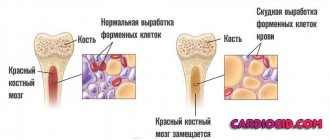The role of calcium in the body
Calcium is an important building element
Calcium (Ca) is one of the most important “building” elements, thanks to which various processes in the body are regulated. The main share is involved in the development of the skeleton, in the growth of teeth, nails, and hair. In addition, calcium performs the following “work”:
- Normalizes metabolism
- Prevents the development of allergic reactions
- Supports cardiovascular function
- Resists inflammatory processes
- Regulates the supply of nerve impulses
- Participates in the process of blood clotting
- Activates the production of hormones and enzymes
- Normalizes the psycho-emotional background
An adult needs to consume at least 0.8 g of calcium per day. For children of the younger age group, the norm is 0.2 g. This amount is necessary to maintain the water-alkaline balance and prevents the development of tissue dehydration and a lack of the element in the bones.
“Extra” calcium, like its deficiency, does not benefit the body, causing pathologies of internal organs. The metabolism of the mineral is promoted by PTH (parathyroid hormone), vitamin D, calcitonin (PTH antagonist, controls calcium excretion by the kidneys).
By controlling the balance of elements in the body, serious diseases can be avoided. According to research by scientists, it has been established that deviations from the norm in calcium levels are fraught with the development of serious pathologies, the list of which includes about 150 items. The most dangerous of them are cancer, osteoporosis (brittle bones), diabetes, and arrhythmia.
The importance of calcium in the body is invaluable: strong bones, a healthy nervous and cardiovascular system, proper functioning of metabolic processes.
From the video, learn more about the role of calcium in the human body.
Hypercalcemia and hypocalcemia
Excess calcium in the blood serum - hypercalcemia - is a biochemical pathology that occurs when the mineral is washed out of bone tissue. The greatest attention should be paid to ionized (free) calcium during the study.
A certain concentration of calcium in the blood is dangerous
Concentrations above 2.6 mmol/l (total) and 1.3 mmol/l (free) are considered hazardous to health. Values may vary depending on the specific laboratory's test method.
There is a mild (up to 2.0 mmol/l of free element), moderate (up to 2.5 mmol/l) and severe form (up to 3.0 mmol/l) hypercalcemia. In a healthy state, the value indicating the amount of an element does not change its indicators.
Changes begin with the development of diseases of the internal organs. In its chronic form, hypercalcemia has mild symptoms and can only be detected after a blood test.
Read: Increased eye pressure is dangerous
An increased calcium content can cause malfunction of the stomach, kidneys (decreased glomerular filtration), heart muscle, and nervous system.
Hypocalcemia is a low level of free calcium in the body (less than 2 mmol/l).
Lack of the element can be caused by endocrine diseases, including hypoparathyroidism (pseudohypoparathyroidism), thyrotoxicosis, pheochromocytoma and parathyrocrinine deficiency. Metastases from neoplasms, kidney disease, pancreas, and sepsis have a negative impact.
Calcium deficiency is common in newborn babies and children of primary and school age. This is due to insufficient consumption of vitamin-rich foods. During the growth process, a child needs to eat well and receive the maximum amount of minerals and trace elements for skeletal development.
Hypocalcemia almost always develops against the background of parathyroid hormone deficiency (hypoparathyroidism), which is produced by the upper and lower parathyroid glands. By interacting with the hormone calcitonin (thyroid), the exchange of phosphorus and calcium in the body is regulated.
Excess calcium, as well as deficiency, develops with deviations in the functioning of organs and systems.
Features of hypocalcemia in children
This pathology can be diagnosed in children of any age. Lack of calcium and phosphorus and vitamin D in the diet is the most common reason that explains the occurrence of a disease such as hypocalcemia. The symptoms of this disease are most pronounced if the child has increased physical and mental stress. It is characterized by the following clinical signs:
- Atypical tetany, which manifests itself in clumsiness during movements.
- Spasms of the calf muscles.
- Persistent diarrhea.
- Increased intracranial pressure.
- Laryngospasm.
Hypocalcemia in children is a very serious pathology that requires immediate treatment. Inattention to a child’s health can lead to the development of the most unexpected complications.
Elevated calcium levels in the blood: causes
The development of hypercalcemia may begin due to increased absorption of the element by the gastrointestinal tract. People who take calcium as a preventive measure for disease must carefully monitor the permitted daily dosage so as not to cause an excess of the mineral in the body. This also applies to the consumption of dairy products (homemade milk, cottage cheese).
In hyperparathyroidism, calcium levels increase
Elevated blood calcium levels most often occur in patients with primary or tertiary hyperparathyroidism.
In most cases, diagnosis reveals benign tumors (adenomas) on the parathyroid gland. The disease develops predominantly in the female half of the population and in those who have undergone radiation therapy in the neck area.
In oncology of the lungs, ovaries, and kidneys, the resulting metastases can penetrate the bone tissue and destroy it, thereby “releasing” calcium. Therefore, patients with malignant tumors have high concentrations of the mineral in their blood serum.
The development of hypercalcemia is caused by hereditary pathologies (hypocalciuric hypercalcemia, endocrine neoplasia), granulomatous lesions (sarcoidosis, histoplasmosis, tuberculosis).
Reasons for increased calcium levels in the body include taking medications containing lithium, theophylline, thiazide diuretics, and thyroid hormones.
Prolonged lack of movement, for example, after fractures, burns, provokes an increase in calcium and resorption (destruction) of bone tissue.
The main causes of hypercalcemia are excess parathyroid hormone in the body (hyperparathyroidism), oncology and long-term use of calcium supplements.
conclusions
Calcium is the basis of bones and an assistant in blood, muscles and blood vessels. He can play for a good team and help the body. Or he can join the team of bad guys and destroy organs by depositing in them.
You can’t take calcium just like that, without measuring it in your blood and without a doctor’s prescription.
Calcium enters our body with food or supplements. Calcium passes from the blood to the bone and, more often, back - from the bones to the blood, destroying them. Donating blood only for general calcium is not very informative. It is necessary to evaluate ionized calcium. Since the process of calcium absorption is affected by vitamin D, phosphorus, magnesium, parathyroid hormone and calcitonin, they need to be checked together.
This is very simple to do: take the “Mineral Metabolism” complex along with a vitamin D test. Take the results to a therapist or osteopath. He will evaluate them and possibly prescribe treatment.
Diagnostics
The level of calcium in the body is determined using a urine test and biochemical blood screening for electrolytes. The amount of magnesium, sodium, phosphorus, chlorine and potassium is also examined.
Laboratory diagnosis of plasma is necessary for latent hypercalcemia
In case of latent hypercalcemia (against the background of low protein levels), laboratory diagnostics of plasma are performed to determine the amount of free calcium. A blood test for free calcium is a more accurate indicator of the level of the mineral in the blood than a total amount test.
Read: Cleaning a smoker’s lungs: proven recipes
To determine the cause of the increased mineral content, a chest x-ray is prescribed, which reveals granulomatous diseases and bone lesions.
The result will be more accurate after a computed tomography or ultrasound scan. Familial hypercalcemia requires special diagnostic methods (molecular genetic testing).
Patients at risk with a hereditary predisposition or cancer are required to undergo examination.
If the disease lasts more than a year, then cancer can be excluded as a cause. In patients with chronic hypercalcemia, hyperparathyroidism is more often detected, which is reflected in the results of laboratory tests for radioimmunology.
Blood test results may be affected by medications, so you should stop taking them two weeks before the test or tell your doctor.
Laboratory blood sampling is carried out in the morning on an empty stomach. To obtain reliable results, it is recommended to follow a diet that excludes the consumption of foods high in building minerals: milk, spinach, fresh herbs, nuts, dried fruits.
The main way to determine excess calcium in the body is a blood test for electrolytes.
Elevated calcium levels in the blood: symptoms
Hypercalcemia occurs without symptoms
Hypercalcemia often goes unnoticed and is detected during a medical examination. Early symptoms of high calcium levels in the blood include:
- Regular constipation
- Pain in the lower abdomen
- Nausea, vomiting
- Polyuria (excessive fluid production by the kidneys)
- Loss of appetite
- Psycho-emotional disorders (depression, psychosis)
Acute hypercalcemia poses a particular danger to the health and life of the patient.
Characteristic signs are disorders of consciousness, coma, hallucinations, high blood pressure, dehydration (dehydration), instability of heart rhythms. If timely medical care is not provided, the patient may die.
The chronic form, which lasts several years, is fraught with complications in the functioning of the kidneys and the formation of stones. There is a constant feeling of thirst, hypotension alternates with hypertension. In an advanced state of the disease, calcium is deposited in the lungs, on the mucous surface of the stomach, and on the walls of the aorta.
The first symptoms of increased calcium levels in the body signal the need for a medical examination in order to prevent a chronic form of the pathology.
About the symptoms of calcium deficiency in a child
Calcium deficiency in children can manifest itself:
- retardation of the child in growth and mental development;
- violation of dental development;
- constant fatigue;
- drowsiness;
- lethargy;
- heart rhythm disturbances;
- instability of blood pressure with a tendency to arterial hypertension;
- disorders of sexual development;
- brittle bones and frequent fractures;
- poor healing of bones after fractures;
- increased bleeding;
- increased sweating;
- emotional instability;
- decreased performance at school;
- poor ability to absorb new information;
- easy bruising.
Treatment methods
After undergoing diagnosis, depending on the severity of hypercalcemia, therapeutic therapy is prescribed aimed at reducing the level of the mineral and removing excess from the body.
If the value in the analysis results does not exceed 2.9 mmol/l, then plenty of fluids and diuretics are prescribed: Furosemide, Torsemide, Hypotheazid.
Potent diuretics can only be used in the absence of renal or heart failure. The mild course of the pathology responds well to therapy; calcium levels return to normal after a course of therapy.
Read: Therapeutic and preventive exercises for the intestines
Hypercalcemia in acute manifestations, when the amount of the element reaches 3.7 mmol/l, requires more serious treatment methods. The patient must be hospitalized and under constant medical supervision until the amount of the element in the blood decreases. In hospital mode, fluid (saline) is administered intravenously.
Diuretics are selected depending on kidney function
Diuretic drugs are selected depending on the performance of the kidneys. To preserve calcium in bone tissue, corticosteroids and bisphosphonates may be prescribed.
The use of calcitonin increases the excretion of the mineral in the urine. Drugs are selected depending on the functionality of internal organs and possible side effects.
In the most difficult cases, surgery is performed, during which the tissue of the parathyroid glands is removed. After surgery, the disease resolves in most patients. Hypercalcemia in cancer pathologies is difficult to treat.
If the tumor increases in size, then therapy aimed at reducing calcium levels does not give the desired result.
Drug therapy to reduce calcium levels in the blood is selected after establishing the causes of the disease and taking into account the severity of the disease.
Diagnostic measures
Usually, this disease is discovered by chance during a routine examination. Low calcium in the blood is detected after a blood test. That is why pathology is diagnosed first, and characteristic symptoms appear later. To determine the reason behind its development, the doctor may additionally prescribe a number of diagnostic measures (biochemical blood test, MRI of internal organs, x-ray of bones, electrocardiography).
Prevention of hypercalcemia
People who are at risk for developing hypercalcemia should pay special attention to their health. First of all, it is necessary to minimize the consumption of foods high in calcium.
You need to be careful with medications containing calcium and vitamin D, and use them only as prescribed by a specialist. If there is a risk of increased calcium levels, then medication should be stopped.
You can remove excess elements from the body if you limit the consumption of dairy products, sesame seeds, fish (in any form), bread, chocolate, and nuts. Carbonated drinks, salt, and coffee “expel” calcium from the body. You should not abuse the listed products, so as not to attract other pathologies to the body.
Doctors recommend replacing regular water with distilled (soft) water, which contains a small amount of minerals. This liquid can be consumed for 2 months. During this time, the body cleanses itself of high levels of elements (calcium, potassium, sodium, etc.). You can also use filters to purify water.
The human body needs a reasonable intake of vitamins and minerals. An increased level of calcium in the blood will not bring any benefit, but will only provoke the development of serious illnesses.
Why is excess calcium dangerous?
There is an opinion that a lot of calcium is good, and a little is bad. It is not true. Sometimes a prolonged increase in calcium levels is not noticeable, but significantly increases the risk of:
- formation of stones in the kidneys, gall bladder and bladder;
- formation of stones in the kidneys, gall bladder and bladder;
- stomach ulcers;
- hypertension;
- vasoconstriction;
- heart diseases.
Sometimes a person feels symptoms, but they are so nonspecific that it is very difficult to suspect a diagnosis based on them. Symptoms may include:
- pain in muscles and bones;
- frequent/profuse urination;
- thirst;
- skin itching;
- abdominal pain, constipation;
- weakness and fatigue;
- depressed mood and memory loss;
- nausea, vomiting and loss of appetite;
- unexplained weight loss.
Calcium Supplements Unfortunately, the common “tradition” of taking calcium supplements “for prevention” can often be detrimental to people's health, as those taking such supplements receive too much calcium. Calcium supplements should be treated like real medicine. You should not take it without a doctor’s prescription, without paying attention to the dosage and without knowing how much calcium you need.











